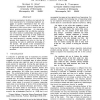Free Online Productivity Tools
i2Speak
i2Symbol
i2OCR
iTex2Img
iWeb2Print
iWeb2Shot
i2Type
iPdf2Split
iPdf2Merge
i2Bopomofo
i2Arabic
i2Style
i2Image
i2PDF
iLatex2Rtf
Sci2ools
IJCAI
1989
1989
Reconstructive Explanation: Explanation as Complex Problem Solving
Existing explanation facilities are typically far more appropriate for knowledge engineers engaged in system maintenance than for endusers of the system. This is because the explanation is little more than a trace of the detailed problem-solving steps. An alternative approach recognizes that an effective explanation often needs to substantially reorganize the line of reasoning and bring to bear additional information to support the result. Explanation itself becomes a complex problem-solving process that depends not only on the line of reasoning, but also on additional knowledge of the domain. We present a new computational model of explanation and argue that it results in significant improvements over traditional approaches.
| Added | 07 Nov 2010 |
| Updated | 07 Nov 2010 |
| Type | Conference |
| Year | 1989 |
| Where | IJCAI |
| Authors | Michael R. Wick, William B. Thompson |
Comments (0)

